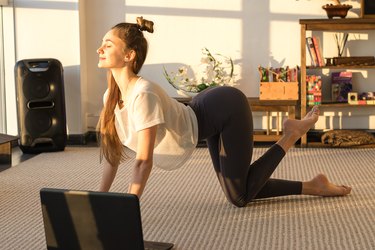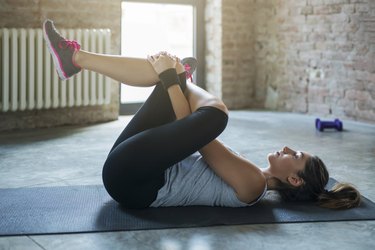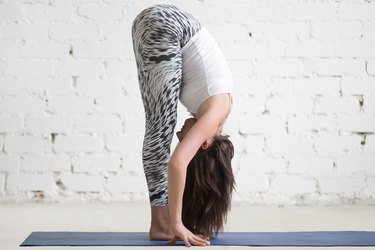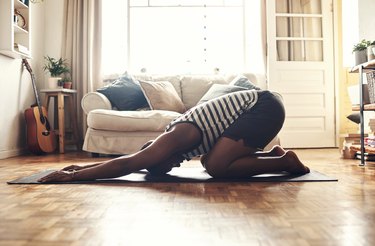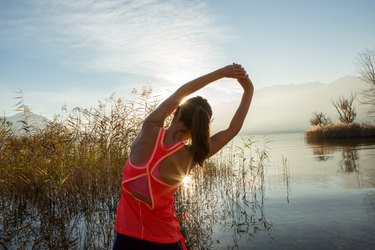
When you start your car in the morning, you don't just floor the gas and take off like a speed racer. Instead, you gently pump the pedal, easing into motion.
You should treat your body the same way after a night's sleep. Before bouncing out of bed into your breakfast bowl, it's best to take a few minutes to warm up those tight muscles with a little stretching.
Video of the Day
Trust us: The benefits of stretching in the a.m. — for as little as five minutes — outweigh any inconvenience. The following eight reasons — like better posture, more energy and fewer aches and injuries — will convince you to start your day with a morning stretch routine.
The Benefits of Stretching in the Morning
1. It Reduces Aches and Pains
Ever wonder why your body feels so stiff in the morning? After a long period of rest without much movement, our muscles tend to grow a little tight. Which is why stretching is a smart idea in the a.m. if you want loose, limber limbs.
"By regularly stretching, we can release muscle tension, promote relaxation and reduce strain on muscles," says Jake Harcoff, CSCS, a certified strength and conditioning specialist and founder of AIM Athletic.
Here's why: When you stretch, you send oxygenated, nutrient-rich blood to your muscles, which facilitates tissue repair and reduces muscle soreness, Harcoff says.
What's more, stretching improves joint flexibility and range of motion (more on this later). This is especially important because "stiff joints can lead to discomfort, [muscular imbalances] and restricted movement, resulting in aches and pains," Harcoff says.
2. It Increases Blood Flow and Promotes Heart Health
If high-intensity exercise in the morning isn't your thing, you can still reap heart health benefits with gentle stretching.
"While stretching alone may not provide the same cardiovascular benefits as other forms of exercise, such as aerobic training, incorporating stretching into your fitness routine can positively affect circulation and blood flow, contributing to overall health and well-being," Harcoff says.
That's because stretching positively affects your blood vessels.
"When we stretch, the muscles undergo a relaxation response, releasing chemicals that promote vasodilation, or the widening of blood vessels," Harcoff says. "This results in increased blood flow, facilitating the delivery of oxygen, nutrients and hormones to the muscles and organs."
Regular stretching also contributes to the health and elasticity of your blood vessels, supporting their ability to expand and contract efficiently, according to Harcoff.
"This improved vascular health enhances overall circulation and blood flow, reducing the risk of cardiovascular issues and promoting better nutrient exchange throughout the body," he says.
3. It Helps Remove Waste From Your Body
Another benefit of stretching is its role in eliminating metabolic waste products, according to Harcoff.
"During physical activity, our muscles produce waste products, such as lactic acid," he says. "By promoting blood flow, stretching assists in the removal of these waste products, aiding in their efficient elimination from the muscles."
We can all agree: Clearing your body of toxins is a terrific way to start the day. Plus, ridding your muscles of metabolic waste helps decrease discomfort and fatigue, Harcoff adds.
4. It Boosts Your Energy Levels
We all hope to wake up feeling refreshed and ready to take on the day. But sometimes we rise feeling more sluggish than rested.
That's why stretching soon after you wake can come in handy — a gentle stretch routine can reenergize your mind and body in several ways.
"Most notably, stretching improves blood circulation, delivering oxygen and nutrients to the muscles and tissues essential for energy production," Harcoff says.
Increased circulation doesn't mean blood only circulates to your muscles — it also goes to your brain.
"The brain requires a significant amount of oxygen to function optimally, so stretching ensures that more oxygen-rich blood reaches the brain, enhancing cognitive function and mental alertness," Harcoff says.
In other words, stretching can help maximize your brain power before you even take a bite of breakfast.
"Secondly, stretching stimulates the release of endorphins, chemicals known for their positive effects on mood and energy," Harcoff says. "Endorphins act as natural painkillers and mood enhancers, promoting a sense of well-being and vitality."
Read: Stretching when the sun rises not only uplifts you physically but mentally too. It's a win-win.
Tip
“It's important to note that while stretching can help to boost energy levels, it is most effective when combined with a well-rounded training program, proper nutrition and sufficient quality sleep,” Harcoff says.
5. It Eases Stress
If your neck, shoulders or back seem to ache more when you're stressed, it's not your imagination. "Chronic stress and tension can manifest as muscle tightness, aches and pains," Harcoff says.
Luckily, a morning stretch practice can help slash stress levels and lessen accompanying muscle aches. "By targeting and stretching tense muscles, you can promote relaxation," Harcoff says.
That's because stretching activates the parasympathetic nervous system, which is responsible for your body's relaxation response, Harcoff explains. When the parasympathetic nervous system is turned on, it shifts your body into a calmer state and "counteracts the effects of the sympathetic nervous system, which triggers the body's 'fight or flight' response."
On top of this, "many stretching exercises incorporate deep breathing [and mindfulness] techniques, which help regulate the body's stress response," Harcoff adds.
In fact, belly breathing boasts a boatload of soothing effects on your mind and body: "Deep breathing increases oxygen intake, slows down the heart rate and promotes a sense of calm," he says.
6. It Enhances Range of Motion
For many, morning muscle stiffness is related to a reduced range of motion, i.e., a measure of how much movement you can make around a joint. Once again, stretching supplies a stellar solution.
"Tight muscles restrict joint mobility," so regularly stretching can help maintain or improve joint mobility and enhance overall joint function, Harcoff says.
By extending range of motion around your joints, your movements become less limited. Here's why that matters: When your joints are stiff and your motion is restricted, your body ends up resorting to compensatory movements and postural deviations, which can cause discomfort and, down the line, even lead to injury, Harcoff says.
Take, for example, your hip flexors, which are notoriously tight. "By stretching muscles such as the hip flexors, we can restore normal range of motion and improve posture affected by issues like anterior pelvic tilt [when the front part of your pelvis is rotated downward]," Harcoff says.
7. It Improves Your Posture
Want to stand a little straighter? Stretching in the morning can help you with that, too. Stretching plays a crucial role in improving posture in multiple ways, according to Harcoff.
For one, "stretching helps to maintain optimal muscle length and balance throughout the body, addressing what is likely to be the underlying cause of poor posture," he says.
Often, poor posture develops due to unhealthy habits like excessive sitting or other repetitive activities (think: always holding your heavy bag on the same shoulder), Harcoff says. But over time, these things can set off muscle imbalances that wreak havoc on your posture.
Along with this, chronic muscle tension can also tug on skeletal structures and contribute to postural imbalances, he says.
Regular stretching helps lengthen tight muscles, enhance your joints' range of motion, improve flexibility and reduce muscle tension, which all work to counteract these imbalances and restore proper posture, Harcoff says.
"Additionally, stretching activates muscles and enhances neuromuscular [mind-body] communication, promoting better postural alignment and stability," he adds.
Tip
“While stretching alone may not correct severe postural issues, it serves as a valuable component within a comprehensive approach that includes strength exercises, corrective movements and ergonomic adjustments,” Harcoff says.
8. It Reduces Your Risk of Injury
We've all been there: Sometimes even the tiniest twist can tweak your neck or back. But a quick stretch straight out of bed may help keep you from getting hurt for a number of reasons.
First, by increasing flexibility and range of motion, stretching allows joints to move freely. This lessens the likelihood of strain or overloading, Harcoff says.
Stretching also promotes healthier muscle function, balance and posture, resulting in better joint alignment, stability and movement mechanics and efficiency and less stress on the joints, he says. Together, all these benefits reduce the risk of compensatory movements and associated injuries (especially from overuse).
"Dynamic stretching is also an effective means of preparing the body for physical activity," Harcoff adds. Through warming up your muscles and increasing blood flow, you help your body gently ease into movement, which cuts your odds of getting hurt. This is especially relevant if you exercise in the morning after a long stint of stasis.
Likewise, stretching after a workout (in the morning or any time) can help you stay injury-free as well. "Stretching as part of a cool-down routine promotes faster recovery, decreases muscle soreness and thus lowers the risk of subsequent injuries," Harcoff says.
The 5 Best Morning Stretches
"In the morning, it's beneficial to incorporate a variety of stretches that target the thoracic spine, lower back, hips, hamstrings and shoulders," which tend to be hotspots for holding tightness and tension, Harcoff says.
Here are some of his favorite stretches for each area. Gently hold each stretch for 30 seconds to 2 minutes and repeat on both sides if applicable.
"Some research has shown stretching benefits begin to drop off after 60 seconds, but I always tell my clients that as long as the stretch feels good, they are welcome to keep doing it," he says.
1. Thoracic Spine: Cat-Cow Stretch
Cat-Cow Stretch
- Begin on your hands and knees.
- Arch your back up toward the ceiling and lift your chin upward into full flexion (cat pose).
- Then, round your back, pull your belly button toward your spine and tuck your chin toward your chest (cow pose).
- Breathe into these spaces and remember to move slowly.
- Continue to move between cat and cow pose, letting your body move with your breath.
2. Lower Back: Child's Pose
Child's Pose
- On your mat, begin by kneeling down with your hips approximately hip-width distance apart, feet untucked, and sit your hips back onto your heels.
- Inhale and elongate your spine. As you exhale, bow forward to fold over your knees and rest your forehead down on the mat.
- Stretch your arms forward with your palms facing down, and gently press your hips back and down onto your feet to stretch your lower back and outer hips.
- If this feels restrictive, try widening your knees even farther apart until you feel more comfortable. Alternatively, you can bring your knees closer together, or all the way together, if that position suits you better. A good rule of thumb is to listen to your body and do what feels right!
3. Hips: Seated Figure 4 Stretch
Seated Figure 4 Stretch
- Start seated with a straight back and both feet flat on the floor.
- Cross your right ankle over your left knee.
- Press your right knee down as far as it can comfortably go and begin to bend forward at the hips without arching your back.
- Hold for desired amount of time, then repeat on opposite leg.
4. Hamstrings: Standing Forward Fold
Standing Forward Fold
- Stand with your feet hip-width apart and arms hanging at your sides.
- Hinge forward at your hips to draw your chest to your thighs, bringing your hands as close to your ankles as is comfortable.
- Rock your weight slightly forward toward your toes to increase the stretch across the backs of your legs.
5. Shoulders: Shoulder Rotation
Shoulder Rotation
- Stand with your feet hip-width apart.
- Keeping your elbow straight, raise your left arm in front of you, leading with your thumb.
- When your arm is straight over your head, rotate your arm so that you lead with your pinky as you bring your arm behind your body.
- Keep dropping your arm until you complete one full rotation.
- Once you finish all your reps here, switch arms.
Was this article helpful?
150 Characters Max
0/150
Thank you for sharing!
Thank you for your feedback!
